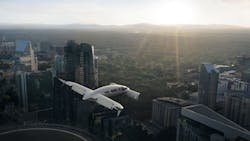Lilium picks Collins Aerospace for flight control
MUNICH - Lilium N.V. in Munich needed flight controls for its all-electric vertical take-off and landing (eVTOL) jet. They found their solution from Collins Aerospace in Cedar Rapids, Iowa.,
Collins, a Raytheon Technologies company, will design, develop, and build the Lilium Jet’s inceptors – the sidestick system used by the pilot to control the aircraft.
The Lilium Jet inceptors, Lilium says, will provide safe and intuitive handling qualities, easy access to functionalities, and an aesthetic, ergonomic design. While integrating all conventional mechanical and electrical flight controls into two sidesticks, the Collins system brings a new piloting philosophy for single pilot operations in the eVTOL realm. The system will also be designed to bring space and weight savings compared to conventional sidesticks.
As part of the supplier agreement, Collins will certify the Lilium Jet’s inceptors to commercial aviation standards.
The Lilium Jet utilizes Ducted Electric Vectored Thrust (DEVT) where electric jet engines integrated into the wing flaps provide advantages in payload, aerodynamic efficiency and a lower noise profile. The engines rely on just a single "stage" rotor/stator system driven by an electric motor with zero emissions
“Our partnership with Collins Aerospace allows us to reap the benefit of five decades of experience in flight deck controls. Our two companies’ collaborative development approach allows us to re-imagine the cockpit and pilot experience, and further strengthens our path towards certification and commercialization,” Yves Yemsi, Chief Operating Officer at Lilium, said.
“Our extensive experience innovating sidestick design is key when tackling the challenges of redefining the entire flight control philosophy for single-pilot aircraft in this new market of advanced regional air mobility,” said Jean-François Chanut, vice president and general manager of Collins Aerospace Propeller Systems. “This innovating and exciting partnership with Lilium is a first step in defining the right solutions toward more automated, sustainable and safe operations for the future of flight”
